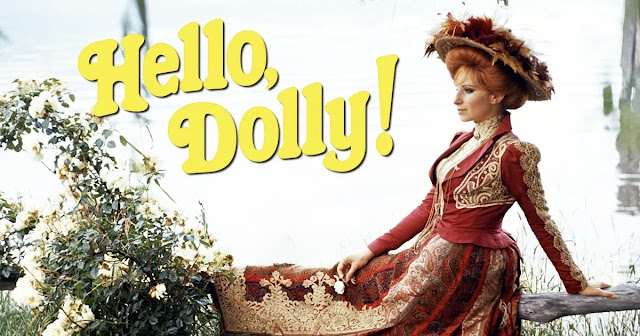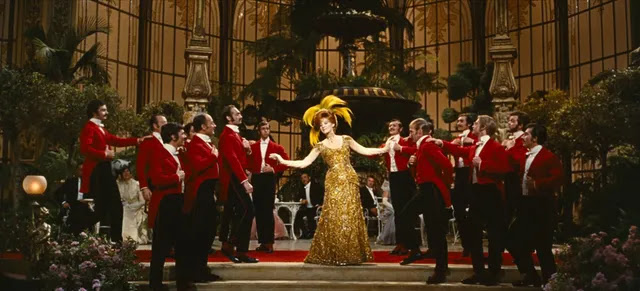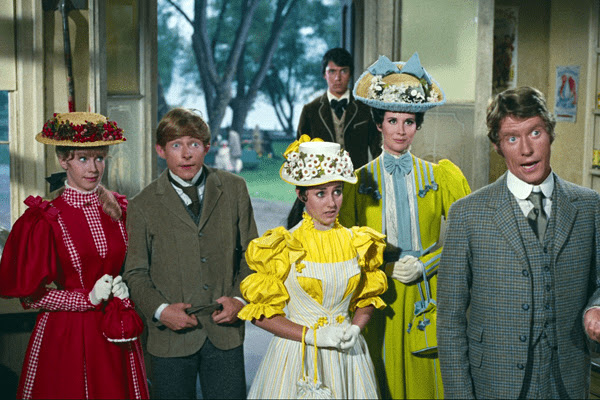Perhaps the best thing that can be said about Hello, Dolly! is that it is lavish. It’s also garish. This Gene Kelly production opens up the stage play by throwing more on the screen than was ever possible on the stage, but the final result is a lesson in why more isn’t always better. It’s only natural to try and open things up and give audiences a reason to go to the big screen over the live theatrical experience, but that doesn’t always work. Hello, Dolly! is ultimately overstuffed and exhausting, filling the screen with people but ultimately using the screen space poorly.
This film has a long and drawn-out history on the stage. It originated as a one-act farce, A Day Well Spent, released in 1842. This was expanded into a full-length play, He’ll Have Himself a Good Time, by Australian playwright Johann Nestroy. Then, in 1938, Thornton Wilder penned his version entitled The Merchant of Yonkers. That play was retooled once again, by Wilder himself, in 1954 and retitled The Matchmaker. Ten years later, Jerry Herman and Michael Stewart teamed up to write the music and book for the stage play Hello, Dolly!based heavily on The Matchmaker. This new version had a successful Broadway run in 1964 and has had many revivals over the years, including on the West End earlier this year. Naturally, with a popular stage musical like this, Hollywood was ready to step in and adapt it for the big screen. Five years after it debuted on Broadway, Hello, Dolly! hit movie theaters just in time for the Christmas season in 1969.
The film was favorably reviewed by critics at the time but struck out with audiences, barely bringing in enough money to cover the production costs. It didn’t start turning a profit until many years later with the home video market. The film almost had to sit on the shelves once completed, losing money for Fox all the while, thanks to a clause on the film rights that prevented the movie’s release while the play was still in production. With the excessive cost of making the film, though, Fox got desperate to recoup that money back and paid an additional 1-2 million dollars to buy out that clause and get their movie into theaters early. The gamble didn’t exactly pay off as rentals fell off rapidly after the first week. There was a bit of a boost in tickets sold when the Oscars were announced but not enough to recover from the elaborate production. At the awards show, it won for a few production categories but nothing else.
The setting is 1890, and well-known matchmaker Dolly Levi (Barbra Streisand) has plans to travel to New York City to find a wife for Horace Vandergelder (Walter Matthau), an unmarried, somewhat wealthy, man and business owner. Meanwhile, his niece, Ermengarde (Joyce Ames), wants to marry young artist Ambrose Kemper (Tommy Tune). Horace opposes the union based solely on Ambrose’s financial instability. Dolly won’t admit it but she has also set her own eyes on Horace and has plans to sabotage his proposal, leaving room for her to sweep in.
Horace plans to travel to New York City to participate in the 14th Street parade as well as to propose to hat-maker Irene Molloy (Marianne McAndrew), whom he met through Dolly. While he is gone, he leaves Cornelius (Michael Crawford) and Barnaby (Danny Lockin) in charge of his store. The two men, however, decide they need to get out and see the city. Dolly overhears this and decides to set them up with Irene and her shop assistant, Minnie Fay (E. J. Peaker), thus freeing Irene from any obligation towards Horace. She also arranges for Ermengarde and Ambrose to go to the city, too, entering them in a dance contest at the fancy Harmonia Gardens restaurant, which she often frequented with her late husband.
From there, all sorts of shenanigans ensue as Cornelius and Barnaby pretend to be wealthy to impress Irene and Minnie Fay, while dodging Horace. Several large dance numbers light up the screen, including one at the Harmonia Gardens that descends into slapstick and pratfalls. Eventually, the whole thing ends right about where you expect it to, with a wedding. This is not a film that is setting you up for a surprise ending.
Looking at Hello, Dolly! now, there are certain things that stand out that contributed to the lukewarm reception it received at the time. The first, unfortunately, is Barbra Streisand. Barbra has screen presence, can sing and dance, and is giving this role her all. The problem really isn’t her, per se, but the role she is cast in. She is entirely unbelievably as a middle-aged widow. She just exudes youthful gaiety which is at odds with the character as it is written. Nothing is done to age her up any, either, which makes for an odd pairing with Walter Matthau who is more than twenty years her senior and looks it. Walter looked old, even when he was young, so pairing him up with the then twenty-seven-year-old Streisand just doesn’t work. On top of the age difference, they don’t have chemistry, either.
The musical numbers are often awkwardly staged, too, which is surprising considering Gene Kelly was at the helm. Many of the dancing sequences are choreographed to play up the comedy, trying to make the main cast look awkward while at the same time maintaining a professional cadence. This can be done well when utilizing everyday activities into the dance numbers like we saw in Seven Brides for Seven Brothers. That isn’t done here and the result is dance sequences that cannot quite balance the humor and the choreography. On top of that, Kelly has added so many extras into nearly every number to juice up the sequences for the big screen, an attempt to give movie theater audiences the spectacle they couldn’t get on a live stage, and it clutters up the screen, over-crowding most of the songs.
Hello, Dolly! is far from a bad film, but it’s the type of film that cannot overcome a truly great live performance and therefore feels inferior in every way. The same thing would happen in other big-stage musical adaptations like Les Misérables (2012) and, most recently, Wicked, Part I. These are not bad films, either, but having seen the stage plays, they don’t hold up in comparison. Hello, Dolly! is a beautiful film to look at and makes great use of color, but it doesn’t take proper advantage of the widescreen format and gets overly cluttered. It’s disappointing more than anything else and does not stand on its own feet, standing apart from the play it is based on.
Academy Award Nominations:
Best Picture: Ernest Lehman
Best Art Direction: John DeCuir, Jack Martin Smith, Herman A. Blumenthal, Walter M. Scott, James Hopkins, and Raphaël Bretton (won)
Best Cinematography: Harry Stradling
Best Costume Design: Irene Sharaff
Best Film Editing: William H. Reynolds
Best Score of a Musical Picture - Original or Adaptation: Lennie Hayton and Lionel Newman (won)
Best Sound: Jack Solomon and Murray Spivack (won)
____________________________________________________
Release Date: December 16, 1969
Running Time: 148 Minutes
Rated G
Starring: Barbra Streisand, Walter Matthau, Michael Crawford, and Louis Armstrong
Directed By: Gene Kelly









Comments
Post a Comment